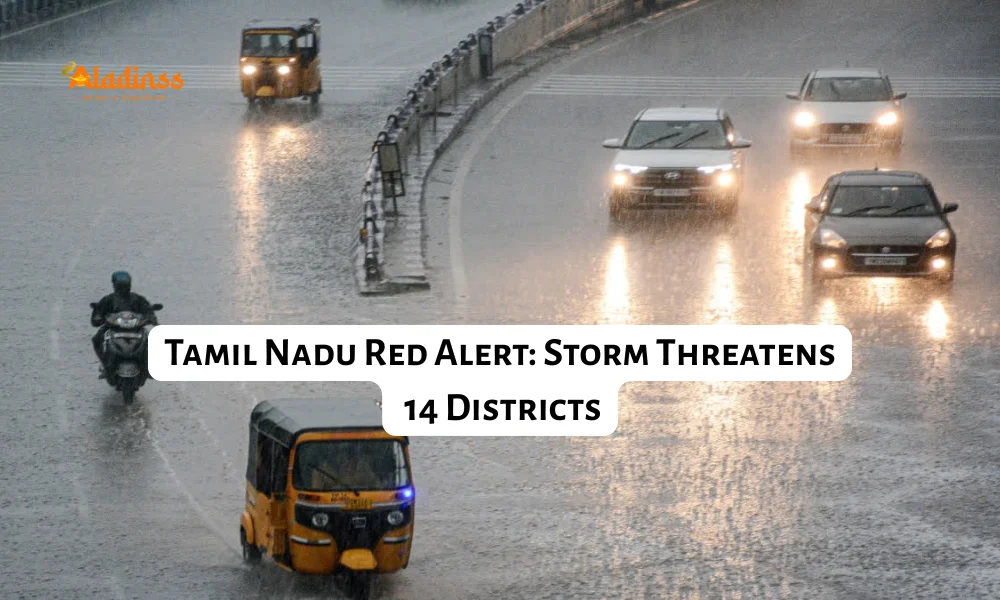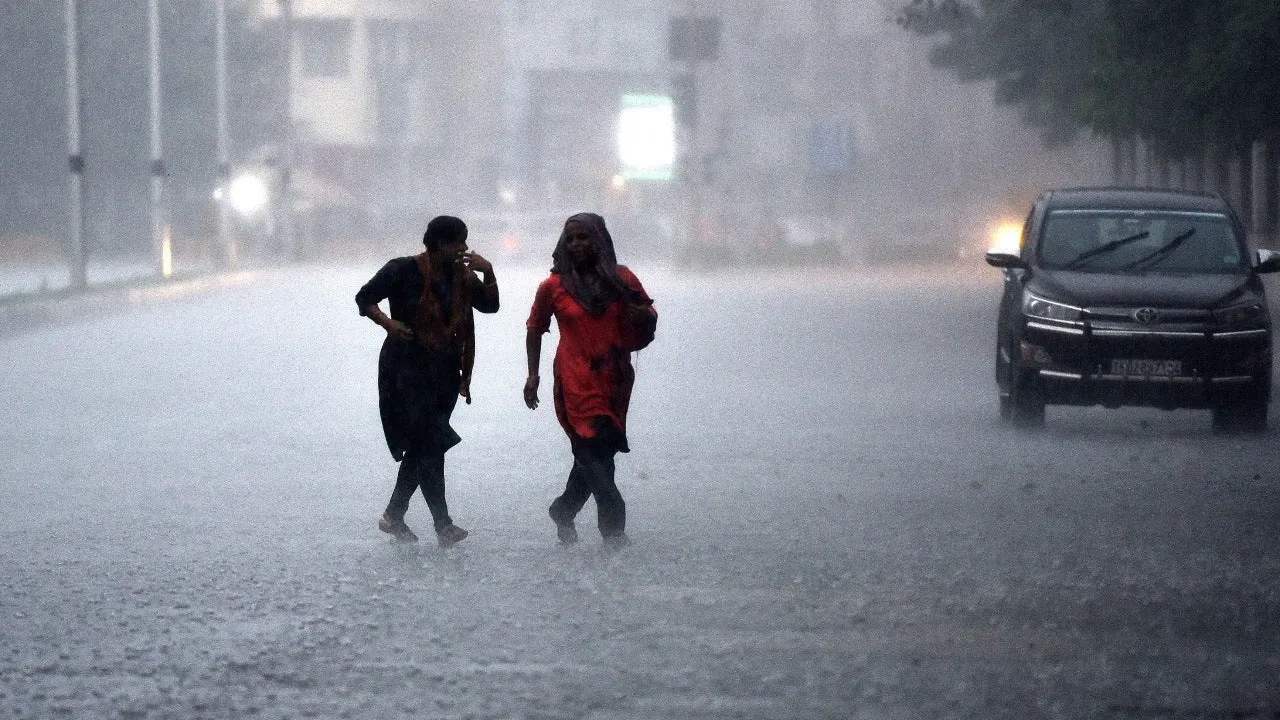Tamil Nadu Weather Alert: Dangerous Storm Approaches, 14 Districts on Red Alert

Tamil Nadu Braces for Storm: Red Alert in 14 Districts
Tamil Nadu is on high alert as a deep depression over the Bay of Bengal threatens to intensify into a low-pressure area, prompting the Regional Meteorological Centre (RMC) to issue a red alert for extremely heavy rainfall in five regions, including Villupuram, Chengalpattu, and Puducherry, on October 22, 2025. Eleven districts, including Chennai, face warnings for very heavy rain, raising concerns about potential flooding and disruptions. The RMC warns that the system could strengthen further, possibly developing into a cyclone, as it moves toward the coasts of Tamil Nadu and Puducherry.
The heavy rainfall has already caused significant disruptions, with authorities implementing emergency measures to protect residents. The forecast indicates continued intense rain across 14 districts, urging residents to stay vigilant and avoid unnecessary travel amidst the escalating Tamil Nadu red alert situation.
Also Read: Tamil Nadu Schools Closed Today as Heavy Rain Batters 19 Districts — IMD Issues Red Alert

Deep Depression Threatens to Become a Cyclone
The RMC in Chennai has forecasted that the deep depression over the southwest Bay of Bengal will likely intensify into a low-pressure area by the afternoon of October 22, 2025. According to Amutha, the Southern Region Head of the Meteorological Department, the system is moving west-northwest toward the coastal areas of North Tamil Nadu, Puducherry, and South Andhra Pradesh. Within the next 24 hours, it could potentially develop into a cyclone, though confirmation is expected later today.
This weather system has already triggered heavy rainfall across Tamil Nadu, with coastal districts bearing the brunt of the downpours. The possibility of cyclonic development has heightened concerns, as it could exacerbate flooding and disrupt infrastructure in already vulnerable areas.
Red Alert for Extremely Heavy Rainfall
A red alert has been issued for five regions—Villupuram, Chengalpattu, Cuddalore, Mayiladuthurai, and Puducherry—indicating the likelihood of extremely heavy rainfall on October 22. These areas face a high risk of flooding, waterlogging, and traffic disruptions, prompting authorities to implement stringent safety measures. The RMC has also warned of very heavy rainfall in 11 districts, including Chennai, Tiruvallur, Kanchipuram, and Nagapattinam, as well as Karaikal.
Additionally, heavy rainfall is expected in districts like Salem, Trichy, and Pudukkottai, with the RMC forecasting continued intense rain across 14 districts in the coming hours. Residents are urged to stay indoors and follow weather advisories to ensure safety during this critical period.
Widespread Rainfall Across 14 Districts
The RMC has identified 14 districts—Chennai, Tiruvallur, Kanchipuram, Chengalpattu, Ranipet, Tiruvannamalai, Villupuram, Cuddalore, Kallakurichi, Nilgiris, Tiruppur, Erode, Tirupattur, and Vellore—as likely to experience significant rainfall in the next three hours on October 22. This widespread impact underscores the severity of the weather system affecting Tamil Nadu, with coastal and interior regions facing potential disruptions.
The forecast for October 23 indicates continued very heavy rainfall in Chennai, Chengalpattu, Tiruvallur, Kanchipuram, and Ranipet, while heavy rain is expected in Vellore, Tirupattur, Tiruvannamalai, Villupuram, Kallakurichi, Cuddalore, and Puducherry. These predictions highlight the prolonged nature of the monsoon’s impact, requiring sustained preparedness efforts.
Government and Emergency Response
Tamil Nadu authorities are taking proactive measures to address the escalating weather crisis. District collectors have implemented emergency protocols, including the deployment of National Disaster Response Force (NDRF) and State Disaster Response Force (SDRF) teams in vulnerable areas. Relief shelters have been established to accommodate residents in flood-prone regions, and local administrations are clearing drainage systems to mitigate waterlogging.
Chief Minister M.K. Stalin has overseen meetings to coordinate disaster response efforts, ensuring that resources are allocated effectively to protect lives and property. Deputy Chief Minister Udhayanidhi Stalin has conducted field inspections to assess the readiness of infrastructure, such as drainage systems and flood barriers, in high-risk areas like Chennai and Villupuram.
Impact on Daily Life and Infrastructure
The heavy rainfall has disrupted daily life across Tamil Nadu, particularly in urban centers like Chennai, where waterlogged roads have led to severe traffic congestion. Public transportation, including buses and trains, has faced delays, while residents in low-lying areas report flooded homes and businesses. The strain on urban infrastructure highlights the challenges of managing extreme weather events in densely populated regions.
Rural areas are also affected, with agricultural communities facing potential crop damage due to prolonged rainfall. The government is working to provide relief to farmers, including financial assistance and support for replanting. Infrastructure repairs, such as clearing blocked drains and reinforcing roads, are underway to restore normalcy in affected areas.
Safety Advisories and Community Response
The RMC has advised residents to avoid unnecessary travel and stay updated on weather alerts. Fishermen have been warned to refrain from venturing into the sea due to rough conditions caused by the low-pressure system. The Indian Coast Guard and Navy are on standby to assist with any maritime emergencies, ensuring the safety of coastal communities.
Communities across Tamil Nadu have shown resilience, with volunteers and local organizations distributing essential supplies to affected residents. Social media platforms are being used to share real-time updates on road conditions, shelter locations, and emergency contacts, helping residents navigate the challenges posed by the Tamil Nadu red alert weather conditions.
Potential Cyclone Threat Looms
The possibility of the low-pressure area developing into a cyclone has heightened concerns across Tamil Nadu. Cyclones can bring devastating winds, heavy rainfall, and storm surges, posing significant risks to coastal communities. The RMC is closely monitoring the system’s trajectory and intensity, with updates expected to clarify the cyclone threat by the end of October 22.
If the system escalates into a cyclone, Tamil Nadu could face widespread disruptions, including damage to infrastructure, agriculture, and livelihoods. Authorities are preparing contingency plans, including evacuation protocols for vulnerable areas, to minimize the impact of a potential cyclonic event.
Long-Term Resilience and Climate Adaptation
The intense rainfall and potential cyclone threat underscore the need for Tamil Nadu to invest in climate-resilient infrastructure. Upgrading drainage systems, reinforcing flood defenses, and improving early warning systems are critical to mitigating the impact of extreme weather events. The state government is exploring sustainable urban planning to address the challenges of urban flooding, particularly in cities like Chennai.
Public awareness campaigns are also essential to educate residents about monsoon preparedness and safety measures. By fostering collaboration between government agencies, communities, and environmental organizations, Tamil Nadu can build a robust framework for managing future weather crises and ensuring the safety of its residents.
Comment / Reply From
No comments yet. Be the first to comment!











